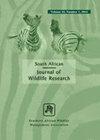The Use of GPS Telemetry Data to Study Parturition, Den Location and Occupancy in the Brown Hyaena
引用次数: 7
Abstract
Inferences about space use, activity and reproduction require an understanding of the behavioural processes that influence animal movements. Large volumes of movement data derived from GPS telemetry devices offer the opportunity to analyse animal behaviour on a very fine scale. GPS and satellite collars were fitted to female brown hyaenas (Parahyaena brunnea) as part of a long-term monitoring study in southwestern Namibia. The date of parturition was determined by comparing changes in movement data and successful GPS positioning attempts. Distances moved on the day of parturition dropped to zero and frequent, unsuccessful GPS positioning attempts on the same day indicated locations in underground dens. Daily distances moved pre-partum, during parturition and post-partum differed significantly and reflected behavioural changes that can be monitored and used to draw inferences about the reproductive state of female brown hyaenas. The main predictors for den occupancy were the age of cubs, distance to closest food source and individual den. Mean occupancy over the entire denning period was 23 days, indicating that brown hyaenas readily move between dens, but individual breeding females showed den site fidelity. Therefore, GPS telemetry is a useful tool to accurately determine parturition in brown hyaenas to draw inferences about den occupancy.利用GPS遥测数据研究棕鬣蜥的交配、巢穴位置和占用情况
对空间使用、活动和繁殖的推断需要了解影响动物运动的行为过程。来自GPS遥测设备的大量运动数据提供了在非常精细的尺度上分析动物行为的机会。作为纳米比亚西南部一项长期监测研究的一部分,为雌性棕色鬣蜥(Parahyaena brunea)安装了GPS和卫星项圈。通过比较运动数据的变化和成功的GPS定位尝试来确定分娩日期。分娩当天移动的距离降至零,同一天频繁、不成功的GPS定位尝试表明了地下窝点的位置。产前、分娩期间和产后的每日移动距离差异显著,反映了行为变化,可以监测这些变化,并用于推断雌性棕色透明体的生殖状态。巢穴占用的主要预测因素是幼崽的年龄、与最近食物来源的距离和个体巢穴。整个巢穴期的平均占有率为23天,这表明棕色鬣蜥很容易在巢穴之间移动,但个体繁殖的雌性表现出巢穴的保真度。因此,GPS遥测是一种有用的工具,可以准确地确定棕色透明羊的分娩情况,从而推断窝的占用情况。
本文章由计算机程序翻译,如有差异,请以英文原文为准。
求助全文
约1分钟内获得全文
求助全文

 求助内容:
求助内容: 应助结果提醒方式:
应助结果提醒方式:


